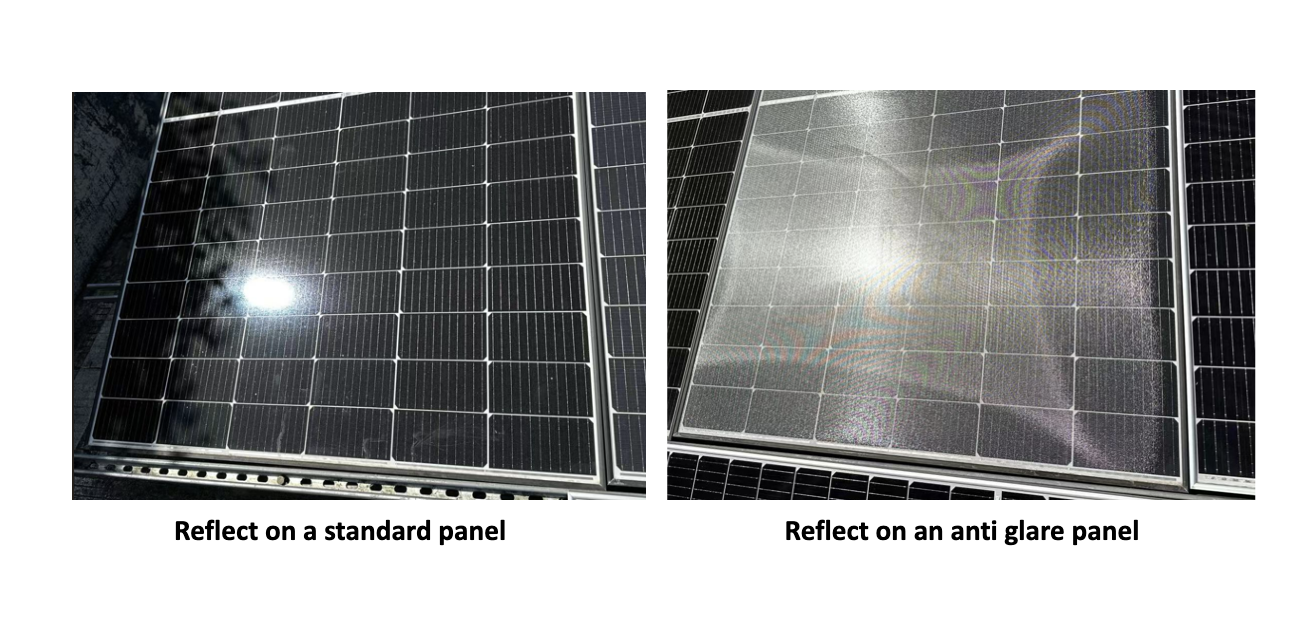Do Dualsun panels have anti-reflective glass and what is their luminance?
It is important to distinguish two types of photovoltaic panels:
“standard” panels
Low luminance panels
“Standard” panels
All panels in the FLASH range are made up of an anti-reflective glass on the front, composed of a thin porous layer of silicon dioxide of ARC (anti-reflective coating) type deposited on the surface of the glass, making it possible to increase transmission of the glass to around 95% at normal incidence (compared to around 91-92% for untreated glass).
This type of glass became popular in the early 2010s and is now a standard component in our industry. It is important to note that the commonly used term “anti-reflective” could suggest that this type of glass is completely transparent, when in reality a certain proportion of incident light remains reflected by the surface of the glass.
Thus a reflectance test valid for all standard panels in the FLASH range determined that approximately 4% of light at normal incidence is reflected by the front glass over the 380-1100 nm range (evaluated value: 3.95% ). Furthermore, approximately 1% of the light is absorbed by the glass, the rest of the light is transmitted towards the cells.
Low luminance panels
In order to further improve the optical properties of the front glass, there is an alternative solution to the anti-reflective glass, called anti-glare glass. This glass is textured so that the light reflected on the surface of the panels is more diffuse, reducing the risk of glare compared to a standard panel.
The regulated luminance for this type of module is less than 15,000 cd/m², i.e. below the threshold of 20,000 cd/m² which was imposed by the DGAC (General Directorate of Civil Aviation) for installers of solar panels in the vicinity of airports until 2022. A certificate of low luminance of the so-called “anti-glare” glasses which will be used on this type of panel can be downloaded here (only available in french).
For projects in airport areas
(This is about french regulation, for other countries please refer to local regulations and laws)
The luminance threshold is longer imposed by the DGAC.
Indeed, the TECHNICAL INFORMATION NOTE of 29/05/2024 (French language) issued by the DGAC and the ministry responsible for transport clearly mention on page 9 that “The risks linked to aerology and dazzling of pilots, air traffic controllers and AFIS agents were considered negligible”.
Anti-glare PV modules may still be required for specific projects. In this case, before preparing an offer for this type of panel, Dualsun request a case by case study, including:
A reverberation study* confirming the need for a low luminance module,
A project greater than 400 kWp or a portfolio of potential projects for this volume because the minimum order is a container, meaning 936 modules FLASH 410 Half-Cut White - Faible Luminance FLASH 425 Half-Cut Glass-Glass TOPCon anti-glare or FLASH 450 Half-Cut Glass-Glass TOPCon anti-glare, or 864 modules FLASH 500 Half-Cut Glass-Glass TOPCon anti-glare
If these two elements are validated, Dualsun can organize a specific production of modules with “low luminance” option, the additional cost of which must be validated individually for each project. Furthermore, the 3 types of panels mentioned above are low-carbon with a Simplified Carbon Assessment (ECS) result of less than 550 kg CO2 Eq/kWp.
In the event that the reverberation study concludes that a low luminance module is not necessary, any panel from the FLASH range may be suitable for this project.
For countries other than France, a specific study of the regulation must be done to be in accordance with the local laws.
According to what standard are luminance tests of solar panels carried out?
There is no specific standard for testing the luminance of solar panels. The method used to measure Dualsun panels is called BRDF (Bidirectional Reflectance Distribution Function), quantifying the ability of a surface to reflect a light wave in all directions in space.
To go further : What is a bifacial module? What performance gains does it allow?

